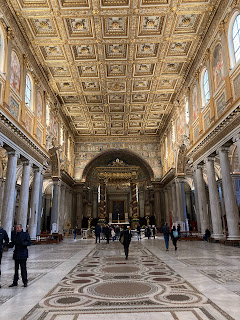+m
This morning I celebrated Mass at the Crucifix Chapel of the Basilica of St. Mary Major for all who gave me intentions for the pilgrimage. St. Mary Major is the oldest basilica dedicated to the Blessed Mother. It was constructed soon after the Council of Ephesus (431) in which Mary was solemnly declared to be the Mother of God. It is one of the few churches in Rome that was never destroyed by invaders or by natural disaster. It is also called "Our Lady of the Snows" since, according to a legend, a family seeking a child through the intercession of Our Lady, made a vow to Our Lady that they would dispose of their property in thanksgiving to her if she indicated the property. On August 5, snow appeared on the top of the Esquiline Hill. It was on this property that the church in Mary's honor was built. This basilica houses a relic of the manger in which Jesus was laid after his birth and the icon of Santa Maria Salus Popoli Romani, Mary, Health of the Roman People. Pope Francis has a special devotion to Our Lady under this title and visits and venerates this image before and after every international trip he makes.
Mass, Chapel of the Crucifix

Mosaic in apse of Mary, the Mother of God
St. Mary Major, nave
Image of Santa Maria Salus Popoli Romani
Reliquary of the Crib
Esta mañana, celebré la Santa Misa en la Capilla del Crucifijo de la Basílica de Santa María la Mayor por todos los que me dieron intenciones para la peregrinación. Santa María la Mayor es la basílica más antigua dedicada a la Santísima Madre. Fue construido poco después del Concilio de Éfeso (431) en el que María fue declarada solemnemente Madre de Dios. Es una de las pocas iglesias de Roma que nunca fue destruida por invasores o desastres naturales. También se le llama "Nuestra Señora de las Nieves" ya que, según una leyenda, una familia que buscaba un niño por intercesión de Nuestra Señora, hizo voto a Nuestra Señora de que dispondrían de sus bienes en acción de gracias a Ella si ella así lo indicaba la propiedad. El 5 de agosto apareció nieve en la cima del monte Esquilino. Fue en esta propiedad donde se construyó la iglesia en honor de María. Esta basílica alberga una reliquia del pesebre en el que fue puesto Jesús después de su nacimiento y el icono de Santa Maria Salus Popoli Romani, María, Salud del Pueblo Romano. El Papa Francisco tiene especial devoción a Nuestra Señora bajo este título y visita y venera esta imagen antes y después de cada viaje internacional que realiza.








Comments
Post a Comment